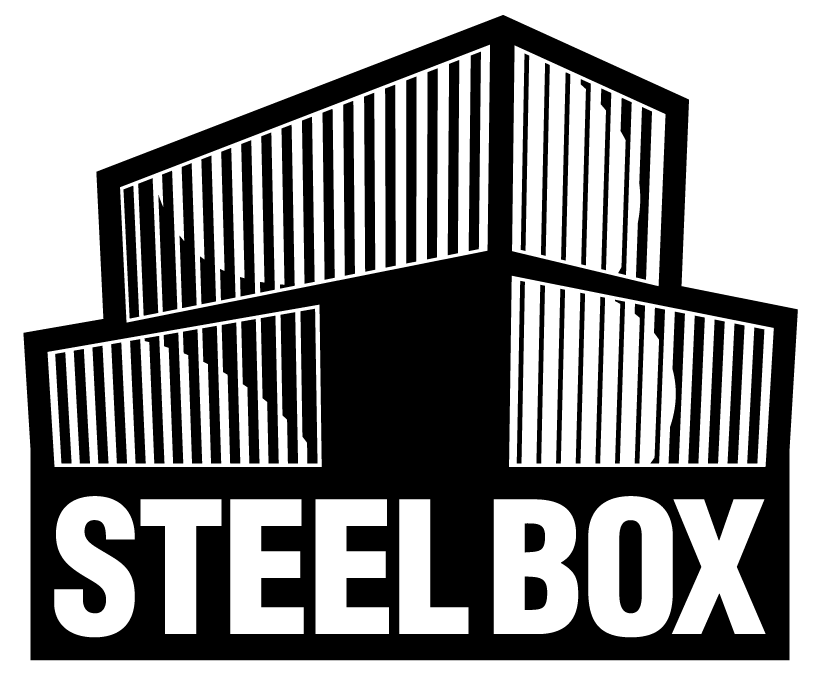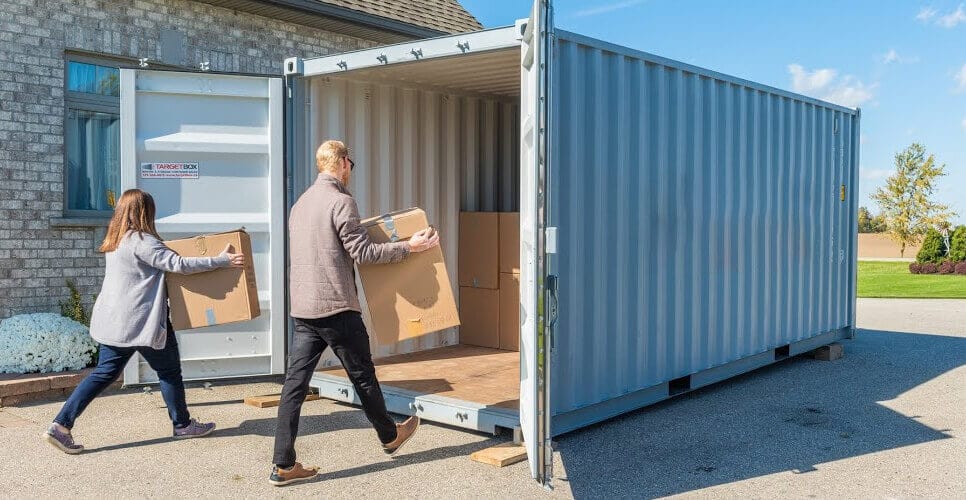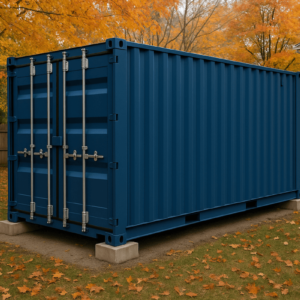Move stress is universal. Boxes, deadlines, a mad dash to do it all in one hectic day. Is there an easier way?
Shipping containers make it possible.
Rent or buy a steel container instead of racing with a moving crew or wrestling a rental truck. Move on your own time, on your own terms. It’s portable storage plus full control of your schedule, your possessions, and your pace.
Shipping containers are a great alternative for moving, whether it’s across town or across the country. Containers give you a secure, weatherproof setup and can be less expensive than full-service movers.
This guide walks you through:
- Choosing the right size container
- Rent vs. buy
- Packing tips and tricks
- What to do with your container after moving
Ready to know more? Let’s go.
Why Use a Shipping Container to Move?
Shipping containers are durable, versatile, and, hands down, one of the most convenient ways to move. Here’s why:
- Complete flexibility with your moving timeline
- Steel walls for security and weather protection
- Moves cost around $3,000 for most households
- Suitable for large, cumbersome items regular movers can’t handle
Take Control of Your Timeline
Here’s the thing: you don’t have to plan your life around a moving company’s calendar.
Using a shipping container? You call the shots.
Take one or two weekends to pack. Organize as you go. The container sits in your driveway until you’re ready to go.
Some perks to taking your time:
- Delivered right when you want it
- Pack over several days or even weeks
- Movers won’t be breathing down your neck
- Pickup takes place only when you’re ready
Most container rental companies provide 30 days or more. That’s all the time you need to finish cleaning out your old place, move into your new home, or even rest in between!
Unmatched Security and Protection
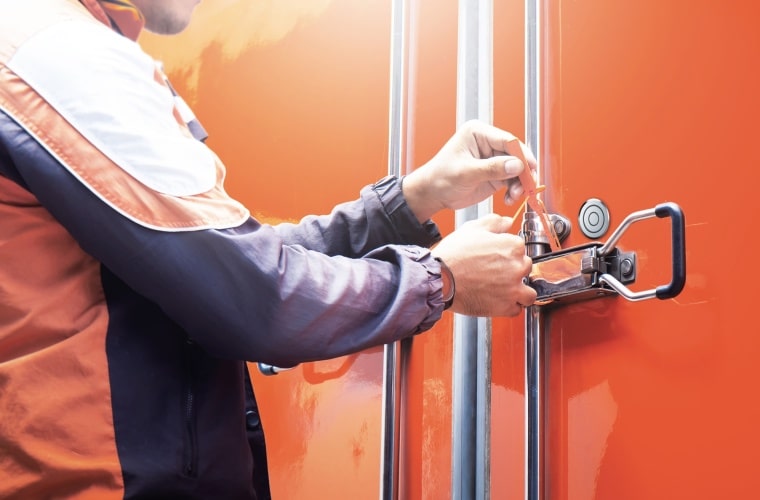
Once you load up your container, no one else is allowed to touch your things.
It arrives sealed. Containers make pit stops in warehouses and other storage facilities along the way. But it’s never opened. No truck exchanges. No re-handling. It’s on a direct shot from Point A to Point B, with zero breaks in between.
Why it’s more secure:
- Steel construction is weatherproof and theft-proof
- Locking doors, and you have the only key
- Your belongings aren’t unloaded and reloaded by a bunch of people you don’t know
- Direct door-to-door transit from your old place to your new home
You pack your items. If you’re meticulous, fragile items can stay in exactly the same position in the same box with your choice of padding and handling.
Rainstorm during your moving day? Doesn’t matter. Road dirt, sleet, or 100-degree heat? No worries.
Save Big and Skip the Headaches
Two things that make people worry during a move: costs and logistics.
Containers solve both. And they do so in a way that’s easier and more affordable than you might think.
Cheaper Than Moving Companies
A full-blown household move with a shipping container? About $3,000 from start to finish. You include drop-off, transport, and pickup.
Compare that to hiring full-service movers. You’ll likely spend $5,000 to $10,000 or more. What gives? Because you’re doing the packing and loading. You’re not paying an army of movers by the hour.
Cost breakdown for container moving:
| Service | Container Cost | Traditional Mover Cost |
| Packing | $0 (we do it) | $500-$2,000 |
| Loading | $0 (we do it) | Included in base price |
| Transport | $2,000-$3,500 | $3,000-$8,000 |
| Total | $2,000-$3,500 | $3,500-$10,000 |
Need storage while you’re between homes? The container can stay right in your driveway or at a secure site for a fraction of the cost of a storage unit. Most storage facilities charge $200–$400/month for similar space. Why pay twice?
Move More Than Just Boxes
Moving containers aren’t only for moving boxes and furniture – they can easily move objects that many moving companies can’t or won’t touch.
The oversized door opening (8 feet wide) allows you to load even extra-large or heavy items without having to make them fit through a small moving truck door.
The kinds of items that are ideal for shipping container moving:
- Vehicles: ATVs, golf carts, motorcycles, small boats
- Workshop Tools: Table saws, welders, large tool chests
- Outdoor Gear: Hot tubs, patio furniture, swing sets
- Appliances: Extra fridges, washers, dryers
And since the floor can support up to 60,000 pounds, you don’t have to worry about weight restrictions. (Typical moving trucks reach their weight capacity quicker than you think.)
Large furniture pieces can be kept upright and in one piece. That means easier assembly, less chance of damage, and less stress when you arrive at your new home.
Your Step by Step Guide to Container Moving
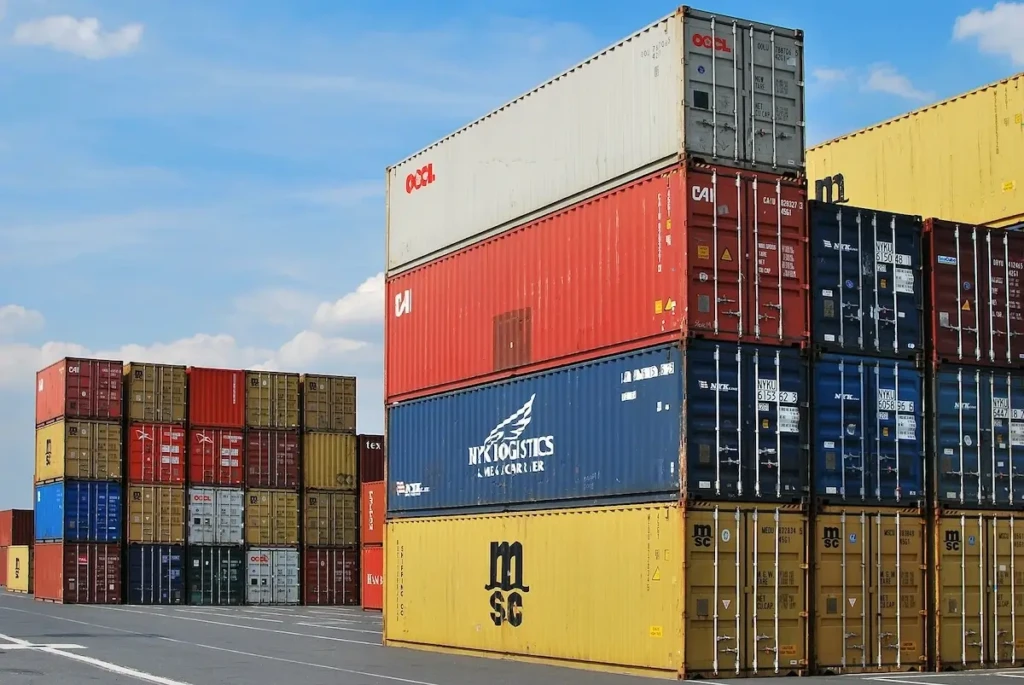
Pack on your own schedule. We ship cross-country. You unpack at your leisure.
Too good to be true? Nope. But like all high-end moves, container moving takes planning and a few tuned up strategies.
Step 1: Planning & Estimating Your Space (Skip This Step and Ruin Your Move)
Y’all, I can’t tell you how many times I see people go wrong on step one.
Most people underestimate how much space they need and make some wild assumptions about the moving process. Container moving planning is where the rubber hits the road.
Container sizes you should care about:
- 20 foot container: 1,170 cubic feet (2-3 bedroom home)
- 40 foot container: 2,390 cubic feet (4+ bedroom home)
Container planning trick: Box everything you own. Walk through your house, open every closet, garage, and storage area. Imagine everything is going to be shipped cross-country.
List every room and every item: kitchen cabinets, bathroom drawers, closets. This step can be extremely tedious, so get a friend to help and don’t try to do it all by yourself.
What’s the second-hardest part? Remembering everything.
Estimate by category:
- Beds, sofas, and chairs: 1 large section, 2 medium, 1 small, a couple of stools
- Kitchen: 2 large, 3 medium, 4 small, 1 extra small
- Closets and bedrooms: 3 large, 4 medium, 10 small, a lot of tiny
Even “tiny” should account for all those pesky cardboard packaging boxes full of screws and parts. Containers are pretty forgiving but not error-proof. Factor an extra 10-15% to be safe.
Step 2: Sourcing Your Shipping Container
Here’s how to find the right box without getting burned.
Rental vs. Buying:
- Rental: $100-300 per month (smart for one-time moves)
- New containers: $3,000-5,000 (overkill for most people)
- Used containers: $1,500-3,000 (good if you need long-term storage)
3 Container Questions to Ask Every Supplier
- 1. What is the condition of the container? (Specific answers are key. Don’t accept “good” or “new” at face value.)
- 2. Are there any dents, holes, or rust spots?
- 3. Do the doors seal well and lock securely?
Get quotes from at least three suppliers. Container prices vary wildly based on location and availability. Shopping around can save you hundreds.
Step 3: Arranging Delivery & Placement
Containers are not delivery vans. The pickup/delivery process is much more complicated.
Delivery and Pickup Requirements:
- Container location: Concrete, asphalt, or packed gravel only. (Woodchips, dirt, and mulch are no-gos.)
- Delivery truck access: 60-foot straight line for delivery truck access. Clear out cars, garbage cans, and trampolines.
- Sidewalks, driveways, and ramps: Must have at least 14-foot overhead clearance. No power lines or tree branches in the way.
- Ground conditions: Solid, compacted ground without soft soil, slopes, or other hazards
- Pre-delivery checklist:
Before Delivery Day:
- Call 811 (or your local underground utility provider) to mark your home
- Clear the delivery path
- Direct the delivery driver for on-site placement and sign the paperwork
Bring it as close to the house as possible. Every foot you’re carrying items to/from the container is an hour of work.
Container trucks and delivery drivers use tilt-bed systems to slide the container off the back of the truck. The driver may be able to shift it a few feet either way for placement, but that’s about it.
Step 4: The Packing Process
Check out the actual packing order that works every time:
- Heavy items first — Appliances, furniture, and book boxes against the front wall.
- Medium-weight boxes — Kitchen, tools, and electronics in the middle section.
- Lighter furniture — Chairs, lamps, and bedroom furniture in the back.
- Fragile items last — With maximum padding and protection.
Securing Your Load:
- Strapping techniques: Use tie-down straps every 8-10 feet along the length of the container.
- Container anchor points: Most containers have anchor points built into the walls and floor.
- Fill gaps: Stuff every gap with pillows, blankets, or packing paper.
- Move items get damaged during transport.
Organization Tips For Your Sanity:
- Label boxes clearly with contents and room name.
- Keep a master list of all contents (digital photos work well).
- Pack a “first day” box with each person’s essentials: Clothes, snacks, toothbrush, toiletries, and so on.
- Use different colored packing tape for different rooms.
Step 5: The Journey to Your New Home
Transport Options:
- Ground shipping: $1-3 per mile for local and regional moves.
- Rail shipping: Less expensive for long-distance moves, but 2-3x longer transit time.
- Expedited service: Available if you’re on a tight timeline (premium pricing)
Questions You’ll Need to Ask:
- Pickup/delivery addresses (include specific placement directions)
- Container size (feet and total loaded weight)
- Pickup and delivery time frame (include any time restrictions)
- Special instructions and access requirements (stairs, narrow doorways)
Weight can be a real moving headache when you don’t know it. Empty 20-foot containers weigh 4,800 pounds. Empty 40-footers are 8,700 pounds. Add your packed contents, and you’re talking 15,000-25,000 pounds total.
Moving companies need this weight information to properly staff with equipment and get the right permits.
Step 6: Unloading at the Destination
The container is finally at your new home. Everything inside it is in exactly the same condition it left your old home. But wait.
Before You Touch Anything:
- Container seal: Check the seal to make sure it wasn’t tampered with during transport.
- Container exterior: Look for new damage from the move.
- Record container’s condition: Take digital photos of the container exterior for your records.
- Inventory: Make sure your detailed inventory list is handy.
Unloading Process:
- Heavy items first — Load dollies, furniture sliders, and extra hands.
- Start at the front and work your way back — Keeps weight balanced in the container as you unload it.
- Release tie-down straps — Items may shift slightly during transport so be careful.
- Room stack: Stack furniture and boxes by room as you unload it.
The container pickup window is typically 24-48 hours after delivery. Time your unload so that you have everything out of the container by pickup time.
Things to Consider When Buying A Shipping Container For Moving
When we buy a shipping container for moving, we need to think about several key factors. These choices will affect how well our move goes and how much we spend.
The most common sizes you’ll see are:
The most common container sizes are:
20ft Standard Container
- Dimensions: 20 feet long, 8 feet wide, 8’6″ tall
- Best for: Apartments, small homes, or partial moves
- Capacity: About 1,000-1,200 cubic feet
- Sweet spot: Single person or couple with minimal furniture
40ft Standard Container
- Dimensions: 40 feet long, 8 feet wide, 8’6″ tall
- Best for: 3-4 bedroom homes, family moves
- Capacity: About 2,400 cubic feet
- Sweet spot: Most residential moves — this is the goldilocks size
40ft High-Cube Container
- Dimensions: 40 feet long, 8 feet wide, 9’6″ tall
- Best for: Homes with tall furniture, artwork, or extra storage needs
- Capacity: About 2,700 cubic feet
- Sweet spot: When you need that extra foot of height for bulky items
Most families moving from a 3-4 bedroom house find that a 40ft standard container handles the job perfectly. But here’s what most people miss: measure your biggest items first. That armoire, piano, or oversized couch will dictate your height requirements more than anything else.
New vs. Used Containers

Used Containers
- Cost: 30-50% less than new
- Condition: Still built like tanks, minor cosmetic wear
- Protection: Full weather resistance and security
- Best for: One-time moves where appearance doesn’t matter
New Containers
- Cost: Higher upfront investment
- Condition: Perfect inside and out
- Protection: Maximum weather resistance
- Best for: Long-term storage plans or resale value priority
Delivery Method Planning
Here’s where a lot of people get blindsided by extra costs.
20ft Containers: The Easy Option
- Standard flatbed trucks can handle delivery
- Easier to maneuver in tight spaces
- Lower delivery costs
- Perfect for urban areas or challenging access
40ft Containers: The Heavy Hitters
- Need specialized equipment (side-lifter trucks or cranes)
- Require more clearance space
- Higher delivery costs
- May need street permits in some areas
Future Use Plans
Smart buyers think beyond the move. Here’s where containers really shine:
Storage Solutions
- Climate-controlled with simple modifications
- More secure than most storage units
- No monthly fees once you own it
- Can be moved if you relocate again
Workspace Conversion
- Home office potential
- Workshop or garage space
- Man cave or she-shed possibilities
- Higher resale value with modifications
Resale Strategy
- Containers hold 70-80% of their value
- High demand in many markets
- Easy to sell through online marketplaces
- Can often break even or profit on your purchase
Even if you just use it for storage after your move, you’re looking at decades of free storage space instead of paying $100-200+ monthly for a storage unit.
Timeline Flexibility
This is where buying a container becomes a total game-changer for your stress levels.
Traditional Moving Timeline:
- Pack everything in 1-2 days
- Load the truck on moving day
- Hope nothing gets damaged or lost
- Unpack immediately or pay storage fees
Container Timeline:
- Pack at your own pace over weeks or months
- Load when you’re ready, not when the truck arrives
- Move on your schedule
- Unpack gradually without storage fees
- Keep it for future moves or storage
Weather Protection
Shipping containers don’t mess around when it comes to weather protection. These things were designed to protect cargo worth millions while crossing oceans in hurricane conditions.
What You Get:
- Completely waterproof when properly sealed
- Wind-resistant up to extreme weather conditions
- Pest-proof construction
- Temperature-stable interior
- Theft-resistant steel construction
What to Do with Your Container After the Move?
Whether you turn it into storage, get creative with a conversion project, or cash out through resale, you’ve got options that actually make sense.
On-Site Storage
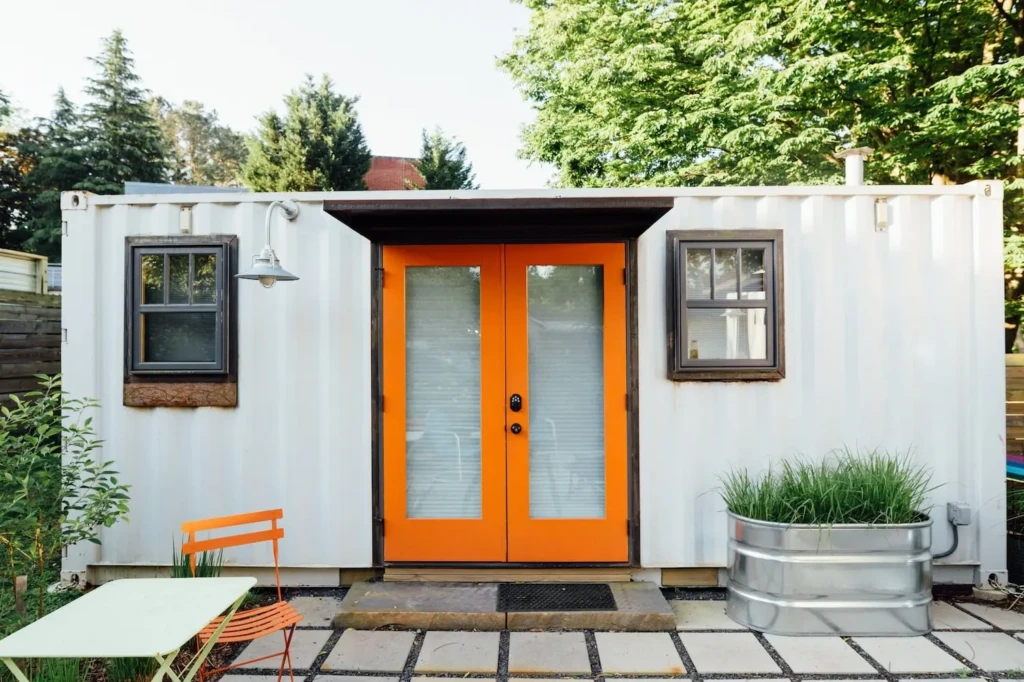
Let’s talk about the most obvious (and honestly, most practical) option: keeping it for storage.
Your shipping container is basically a ready-made, bulletproof storage unit that never charges monthly fees. These things are weatherproof and secure by design, which means your stuff stays dry and safe without you lifting a finger.
Perfect for storing:
- Seasonal decorations and holiday gear
- Lawn equipment and outdoor furniture
- Business inventory and supplies
- Tools and workshop overflow
Storage advantages:
- Weather-tight protection from everything Mother Nature throws at it
- Built-in security with heavy-duty locking mechanisms
- No permits needed like traditional outbuildings
- Ready to use immediately no construction headaches
Pro Tip: Add some battery-powered LED lights and basic shelving inside for easy organization. Position it where you want permanent storage since moving it later requires special equipment and costs.
Creative Repurposing
Feeling ambitious? Your container can become way more than just storage.
Popular conversion projects include workshops, art studios, and even mini garages. With some strategic modifications, you can create functional workspace that’s completely customized to your needs.
Smart conversion ideas:
- Workshop Space — Add electrical wiring and ventilation for woodworking or mechanical projects
- Art Studio — Install windows and insulation for year-round creative work
- Mini Garage — Perfect for motorcycles, ATVs, or lawn tractors
Basic modifications like cutting doors or windows are totally doable, but hire professionals for electrical work and major structural changes. And definitely check local building codes first — some areas have specific requirements for container modifications.
Reselling
Containers hold their value surprisingly well. If you’d rather have the cash, you can resell yours and recoup most of what you spent.
Typical resale prices:
- 40-foot containers: $3,000–$5,000
- 20-foot containers: $2,000–$3,500
(Condition and location will shift these numbers.)
Selling tips:
- Clean it out and take clear photos.
- Original (unaltered) containers often sell faster and for more.
- Get multiple quotes—prices vary by region.
- List on marketplace sites, contact local dealers, or check with construction companies.
On average, reselling takes 2–4 weeks depending on local demand.
Ready to Simplify Your Move?
Moving with a shipping container isn’t just different from traditional moving, it’s better in every way that actually matters. You get complete control over your timeline (pack when you want, move when you’re ready), bulletproof protection for your belongings (these steel boxes survive ocean crossings, they can handle your move), and zero stress from rushing around someone else’s schedule. Instead of juggling multiple moving pieces, rental trucks, storage units, and tight deadlines, you get one container that handles everything: your portable storage unit and moving truck rolled into one smart solution. The result? Lower stress, better protection for your stuff, cost savings from doing it your way, and the kind of moving experience that actually makes sense. Whether you need a 20ft container for a smaller move or a 40ft beast for the whole house, the right container choice transforms moving from a nightmare into something you can actually control and that’s worth every penny.
Ready to move on your own terms? Steel Box Shipping Containers offers new and used containers, flexible delivery options, and the expert guidance to help you choose the perfect size. Call us today and make your next move the easiest one yet.

